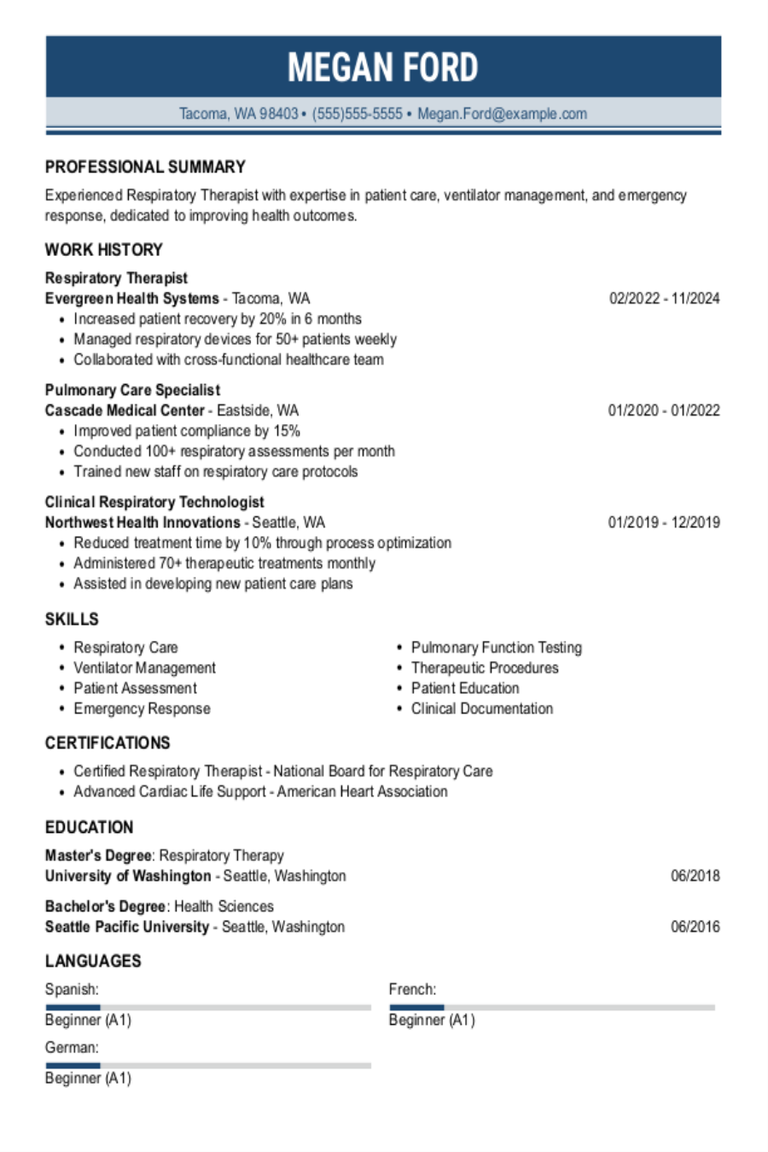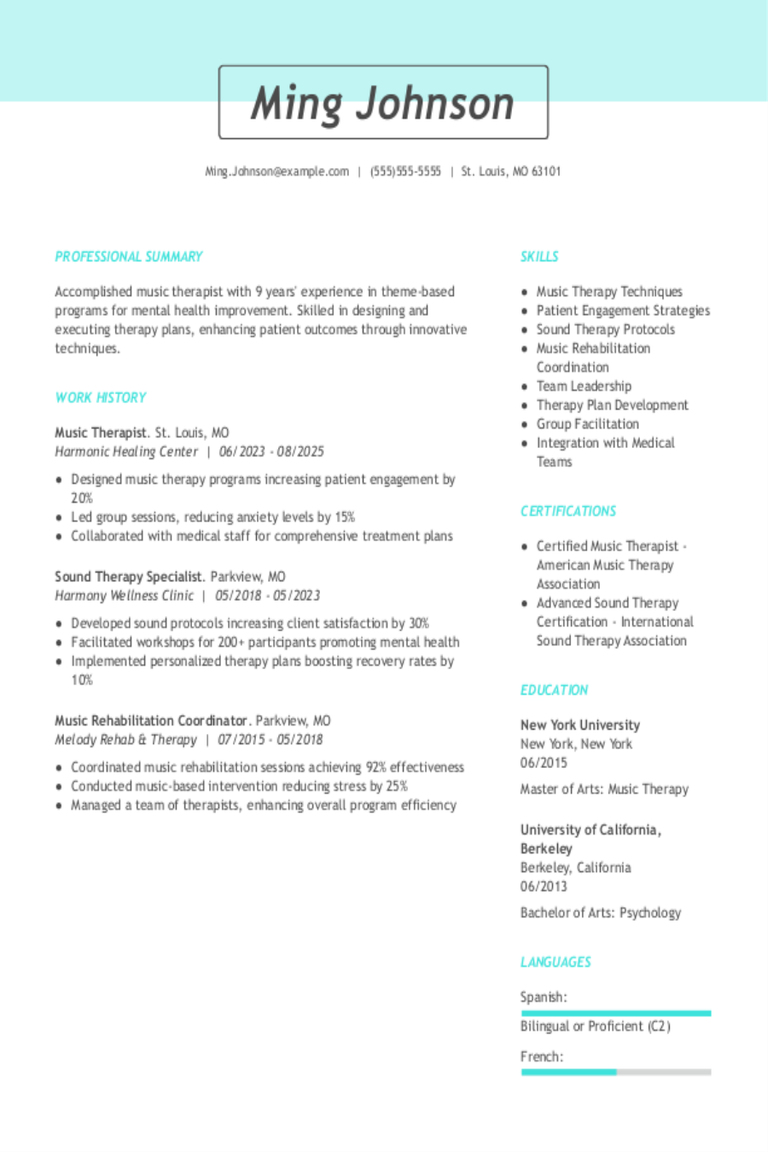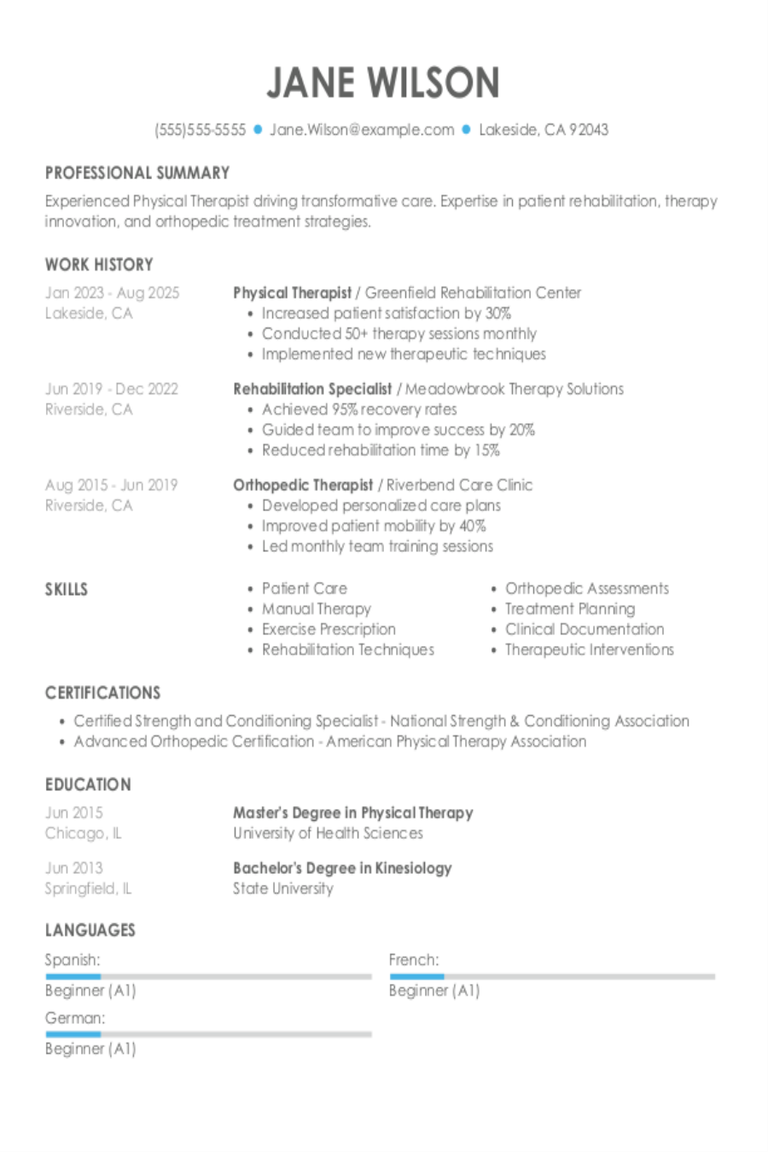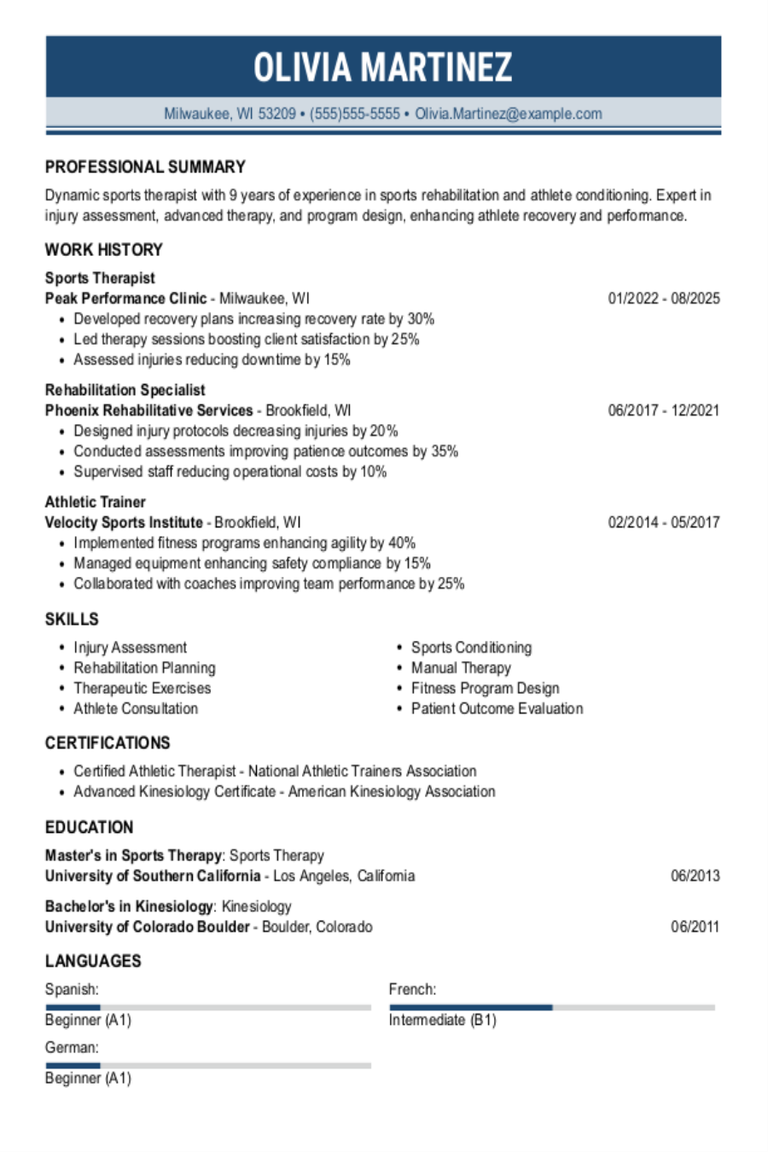Why this resume works
- Highlights industry-specific skills: By integrating healthcare skills from roles like occupational therapist and rehabilitation specialist, the applicant demonstrates deep expertise in effective patient care.
- Quantifies accomplishments: Measurable accomplishments, such as improving patient mobility by 40%, effectively illustrate the applicant’s impact, showcasing quantifiable success in therapy strategies.
- Showcases career progression: The progression from clinical therapy assistant to occupational therapist highlights increasing responsibility, reflecting a clear trajectory of career advancement and expertise development.
More Occupational Therapist Resume Examples
Review our occupational therapist resume examples to highlight your patient care skills and therapeutic expertise. These healthcare support resume samples help you create a compelling resume that showcases your impact in therapy roles.
Entry-Level Occupational Therapist
Why this resume works
- Centers on academic background: The applicant’s education section stands out with a strong academic foundation in health sciences and occupational therapy.
- Effective use of keywords: By weaving in keywords like “patient-centered care” and “evidence-based practice,” the resume is tailored to navigate applicant tracking systems (ATS) and stand out to hiring managers.
- Shows digital literacy: Managing clinical documentation alongside ergonomic assessments showcases computer skills and digital readiness, aligning with modern workplace requirements.
Mid-Level Occupational Therapist
Why this resume works
- Includes a mix of soft and hard skills: Combining technical strengths like therapeutic protocols with interpersonal skills, the applicant balances patient care expertise and team leadership to create impactful rehabilitation outcomes.
- Points to measurable outcomes: By citing measurable achievements such as improving patient functionality by 30% and reducing session duration by 15%, the applicant illustrates a results-oriented approach to therapy solutions.
- Displays technical expertise: With certifications in advanced rehabilitation techniques and an occupational therapy license, the applicant showcases specialized expertise critical for effective treatment planning and case management.
Experienced Occupational Therapist
Why this resume works
- Lists relevant certifications: By listing certifications such as Certified Hand Therapist, the applicant showcases a commitment to skill mastery, supporting their expertise in occupational therapy.
- Showcases impressive accomplishments: Increasing patient retention by 30% and launching wellness initiatives show the applicant’s ability to deliver impactful results.
- Emphasizes leadership skills: Leading workshops that boost team efficiency by 20% illustrates the applicant’s proactive leadership skills and initiative.
Occupational Therapist Resume Template (Text Version)
Hiro Nakamura
Portland, OR 97201
(555)555-5555
Hiro.Nakamura@example.com
Professional Summary
Expert occupational therapist with 7 years of success in designing patient-centric therapy plans. Skilled in therapeutic planning, team collaboration, and healthcare compliance, driving recovery improvement rates. Known for optimizing patient mobility and satisfaction while educating families on care techniques.
Work History
Occupational Therapist
Sunrise Rehabilitation Center – Portland, OR
January 2023 – July 2025
- Designed therapy plans improving patient mobility by 40%
- Collaborated with healthcare teams to optimize recovery rates
- Educated families on care techniques, reducing rehospitalizations
Rehabilitation Specialist
Meadowbrook Recovery Clinic – Portland, OR
June 2018 – December 2022
- Assessed patient needs, improving therapy effectiveness by 30%
- Implemented new recovery strategies boosting satisfaction scores
- Supervised assistants ensuring compliance with care protocols
Clinical Therapy Assistant
Harmony Health Center – Portland, OR
June 2016 – May 2018
- Supported therapists in sessions enhancing patient outcomes
- Documented treatment plans improving record accuracy by 25%
- Coordinated equipment reducing setup overheads by 15%
Skills
- Patient Assessment
- Therapeutic Planning
- Team Collaboration
- Family Education
- Healthcare Compliance
- Record Management
- Rehabilitation Coaching
- Multimodal Therapy Techniques
Education
Master of Science Occupational Therapy
University of Texas at Austin Austin, Texas
June 2014
Bachelor of Science Health Sciences
Texas State University San Marcos, Texas
June 2012
Certifications
- Certified Hand Therapy Specialist – American Therapy Certification Board
- Advanced Neurological Rehabilitation – National Association of Rehabilitation Professionals
Languages
- Spanish – Beginner (A1)
- French – Intermediate (B1)
- German – Intermediate (B1)
Related Resume Guides
Advice for Writing Your Occupational Therapist Resume
Discover how to highlight your skills and passion for helping others with our tips on how to write a resume for an occupational therapist role. Whether you’re just starting or looking to take the next step in your career, we’ll provide advice to help you stand out and connect with opportunities in healthcare.

Write a strong professional summary
A professional summary is a short introduction at the top of your resume that helps hiring managers quickly understand who you are as an applicant. You can decide whether to use a summary or a resume objective based on your experience level and career goals.
A professional summary highlights your experience, skills, and achievements in three to four sentences. It’s ideal for those with some work history who want to showcase their professional identity and the value they bring. This section focuses on “what I’ve accomplished” and helps set you apart from other applicants.
In contrast, resume objectives are statements about your career goals and what you aim to contribute in a new role. They work best for entry-level applicants, career changers, or those with employment gaps. The objective emphasizes future potential rather than past accomplishments.
Next, we’ll provide examples of both summaries and objectives tailored for different industries and experience levels to help you craft the perfect introduction for your resume as an occupational therapist. Explore our full library of resume examples for additional inspiration.
Occupational therapist resume summary examples
Entry-level
Recent graduate with a Master of Occupational Therapy from an ACOTE-accredited program. Completed internships in diverse clinical settings, focusing on pediatric developmental delays and geriatric care. Certified in Basic Life Support (BLS) and skilled in administering standardized assessments and creating individualized treatment plans. Eager to apply foundational knowledge and support clients in achieving greater independence.
Mid-career
Occupational therapist with over six years of experience working in rehabilitation centers and hospital environments. Expertise in developing client-centered therapy interventions and improving activities of daily living for individuals recovering from strokes or surgeries. Licensed in New York, certified in sensory integration techniques, recognized for strong patient advocacy and collaborative team approach.
Experienced
Seasoned occupational therapist with a specialization in hand therapy and ergonomic assessments. Over 15 years of experience leading therapy teams, implementing evidence-based practices, and optimizing patient recovery pathways. Certified hand therapist (CHT) with a track record of reducing recovery times through innovative splinting techniques and comprehensive rehab programs. Committed to advancing the field through mentoring emerging therapists.
Occupational therapist resume objective examples
Recent graduate
Dedicated and enthusiastic recent occupational therapy master’s program graduate seeking an entry-level position to apply academic knowledge and hands-on experience in a collaborative healthcare environment. Committed to improving patient independence and quality of life through personalized therapeutic interventions.
Career changer
Passionate individual transitioning into occupational therapy with a background in education, aiming to apply strong communication skills and creative problem-solving abilities in facilitating patient rehabilitation. Excited to contribute positively to a diverse team while promoting holistic wellness for clients.
Specialized training
Newly licensed occupational therapist with specialized training in sensory integration and pediatric therapy, eager to join a forward-thinking clinic. Driven by the opportunity to support children and families in achieving developmental milestones through targeted, innovative therapies tailored to individual needs.
Make your occupational therapist resume stand out with our Resume Builder. Choose a template, add your details, and get a professional-looking resume quickly and easily.
Include relevant certifications and training
Listing certifications and training is important for an occupational therapist because it shows you have the right skills and knowledge. Certifications like these prove that you’re up-to-date with industry standards and committed to providing high-quality care. They also help employers easily see your qualifications, making you stand out among other job seekers. Here are a few examples of certifications for your resume:
- Certified Occupational Therapy Assistant (COTA)
- Advanced Certified Autism Specialist (ACAS)
- Neuro-Developmental Treatment Certification
- Hand Therapy Certification
- Sensory Integration Certification
Having a dedicated certifications section on your resume highlights your expertise as an occupational therapist. These credentials can be just as important as your education because they show specific skills that are needed in this field.
Example of a certifications section
Licensed occupational therapist (OTR)
Issued by: National Board for Certification in Occupational Therapy (NBCOT)
Expires 2025
Certified hand therapist (CHT)
Issued by: Hand Therapy Certification Commission (HTCC)
Issued 2021
Pediatric occupational therapy certification
Issued by: American Occupational Therapy Association (AOTA)
Issued 2023
Sensory integration and praxis test certification
Issued by: University of Southern California Division of Occupational Science and Occupational Therapy
Expires 2026
Use a polished and well-organized resume template that effectively showcases your skills and qualifications to stand out to hiring managers in the healthcare industry.
Showcase your work experience
Having a well-organized work experience section on your resume is key for an occupational therapist. This part of your resume shows potential employers what you’ve done in the past and how you can help them in the future. Start by listing your jobs in reverse order, with the most recent job at the top. Include your job title, employer’s name, location, and employment dates for each position.
Use action words to describe what you did in each role. For example, instead of saying “responsible for patient care,” say “improved patient mobility through tailored therapy plans.” Whenever possible, include numbers to show your impact, like “increased patient recovery rates by 20%.”
Highlight core responsibilities such as developing treatment plans, conducting assessments, coordinating with healthcare teams, and educating patients and families. Mention any special projects or programs you initiated or improved.
By clearly outlining your work experience as an occupational therapist, you make it easier for hiring managers to understand the skills and value you bring to their team. Keep it concise but informative to make a strong impression without overwhelming them with details. Remember that each entry should give a snapshot of your abilities and achievements that align with the job you’re applying for.
5 occupational therapist work history bullet points
- Developed individualized treatment plans for 30+ patients monthly, improving patient outcomes by 25% within six months.
- Collaborated with multidisciplinary teams to create holistic care approaches, resulting in a 20% increase in patient satisfaction scores.
- Implemented evidence-based therapeutic techniques, decreasing patient hospital readmissions by 15%.
- Mentored and trained 5 occupational therapy assistants, improving team skills and efficiency by 40%.
- Conducted comprehensive assessments for patients with neurological disorders, achieving a 30% improvement in their functional independence.
Choose a resume format that highlights your therapy techniques, patient interaction skills, and successful treatment plans in a clear and logical way.
Match your resume with the job description
Tailoring resumes to job descriptions is essential for job seekers wanting to stand out. It helps pass through applicant tracking systems (ATS) by using specific keywords and phrases from the job postings. ATS scans resumes to match these terms, making it easier for employers to find suitable candidates.
An ATS-friendly resume includes keywords that align with your skills and experience. By incorporating these terms, you increase your chances of getting noticed by hiring managers, as the system flags resumes with relevant words.
To tailor your resume effectively, start by identifying keywords in job postings. Look for repeated skills, qualifications, and responsibilities—these are often prioritized by both applicant tracking systems (ATS) and hiring managers.
For an occupational therapist position, common keywords might include “patient care,” “treatment planning,” “functional assessments,” or “interdisciplinary collaboration.” Use these terms naturally throughout your resume. Instead of copying job description phrases verbatim, reflect your experience using similar language.
For example, if a posting says “provide high-quality patient care,” you could write: “Delivered high-quality patient care focused on improving daily functioning and long-term independence.”
Targeted resumes improve ATS compatibility and help you connect more effectively with hiring managers. This increases your chances of securing interviews and landing the occupational therapist role. Make sure to customize your resume for each application to highlight how closely you fit the job requirements.
Make sure your resume gets through applicant tracking systems! Our ATS Resume Checker finds common problems and gives tips to make your resume better.
Salary Insights for Occupational Therapists
Exploring salary data provides valuable insights into industry trends and typical pay ranges. This information helps you make informed decisions about your career and negotiate with confidence.
Top 10 highest-paying states for occupational therapists
Occupational Therapists earn varying salaries across the United States, with a national average of $94,586. The table below highlights the states where occupational therapists command the highest compensation.
Our salary information comes from the U.S. Bureau of Labor Statistics’ Occupational Employment and Wage Statistics survey. This official government data provides the most comprehensive and reliable salary information for occupational therapists across all 50 states and the District of Columbia. The figures presented here reflect the May 2025 dataset, which is the most recent available as of this publication.
| State | Average Salary |
|---|---|
| California | $117,120 |
| Nevada | $110,320 |
| Oregon | $108,430 |
| District of Columbia | $107,690 |
| New Jersey | $107,600 |
| Washington | $105,160 |
| Texas | $103,150 |
| Oklahoma | $102,140 |
| New Mexico | $102,560 |
| Connecticut | $101,120 |
FAQ
Do I need to include a cover letter with my occupational therapist resume?
Yes, including a cover letter with your occupational therapist resume can boost your application by providing deeper insight into your qualifications and passion for the role. A cover letter lets you explain why you’re drawn to this particular position and organization, allowing you to highlight specific skills or experiences that align with their needs.
For example, if the facility emphasizes rehabilitation for certain conditions or uses innovative therapeutic techniques, mention any relevant experience or training you have in those areas. Check out occupational therapist cover letter examples for more targeted tips.
Use tools like our Cover Letter Generator to craft a personalized letter based on your resume details, or start from scratch with expert guidance tailored to occupational therapy.
Additionally, exploring our library of cover letter examples can offer inspiration and help you create a document that resonates well with employers in your field.
How long should an occupational therapist’s resume be?
For an occupational therapist, aim for a one-page resume if you’re early in your career or have less than 10 years of experience. This should cover key skills like patient evaluation, treatment planning, and therapeutic techniques.
If you have extensive experience or specialized certifications, a two-page resume may be appropriate. Make sure every detail is relevant to demonstrate your expertise in patient care and rehabilitation outcomes.
Check out our guide on how long a resume should be for more examples and tips on determining the ideal length based on your career stage.
How do you write an occupational therapist resume with no experience?
If you’re starting as an occupational therapist with no work experience, focus on highlighting your education and relevant skills that show your potential in the field. Here are a few tips on writing a resume with no experience:
- Emphasize your education: Start with your degree in occupational therapy, including the name of the institution, graduation date, and any honors or awards. Include any certifications you’ve earned, such as NBCOT certification or state licensure.
- Use clinical placements to showcase experience: Detail your clinical placements by describing the hospitals or outpatient clinics you worked in. Highlight specific tasks performed during these rotations, such as conducting assessments and developing treatment plans.
- Highlight transferable skills: Mention skills relevant to occupational therapy that you’ve gained through volunteer work, internships, or coursework—such as communication abilities, empathy, problem-solving skills, and familiarity with therapeutic techniques.
Remember to tailor your resume for every job you apply to, ensuring it highlights the skills and experience most relevant to each position.
Rate this article
Occupational Therapist
Additional Resources

Occupational Therapist Cover Letter Example & Templates
Occupational Therapist jobs vary based on who they’re helping and their patient’s particular disability. They work with people of all ages, helping them adapt to new challenges like learning new

Behavioral Therapist Resume Examples & Templates for 2025
Browse behavioral therapist resume examples and learn how to highlight communication skills, empathy, and experience with different age groups while demonstrating your ability to create positive change in people’s lives.Build

Respiratory Therapist Resume Examples & Templates for 2025
Browse respiratory therapist resume examples to see how to showcase your experience caring for patients with breathing problems and working with medical teams. These samples help you highlight your skills

Music Therapist Resume Examples & Templates for 2025
Explore music therapist resume examples and tips to learn how to highlight your experience supporting clients, using music as a tool for healing, and building strong connections through creative therapy.Build

Physical Therapist Resume Examples & Templates for 2025
Discover physical therapist resume examples and learn how to showcase your ability to improve patient mobility and recovery.Build my resumeImport existing resumeCustomize this templateWhy this resume worksHighlights industry-specific skills: By incorporating

Sports Therapist Resume Examples & Templates for 2025
Discover sports therapist resume examples and learn how to show your skills in injury assessment, treatment planning, and athlete support to stand out.Build my resumeImport existing resumeCustomize this templateWhy this
